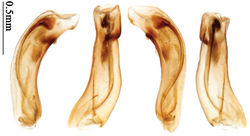Dasiosoma indicum
| Notice: | This page is derived from the original publication listed below, whose author(s) should always be credited. Further contributors may edit and improve the content of this page and, consequently, need to be credited as well (see page history). Any assessment of factual correctness requires a careful review of the original article as well as of subsequent contributions.
If you are uncertain whether your planned contribution is correct or not, we suggest that you use the associated discussion page instead of editing the page directly. This page should be cited as follows (rationale):
Citation formats to copy and paste
BibTeX: @article{Shi2013ZooKeys284, RIS/ Endnote: TY - JOUR Wikipedia/ Citizendium: <ref name="Shi2013ZooKeys284">{{Citation See also the citation download page at the journal. |
Ordo: Coleoptera
Familia: Carabidae
Genus: Dasiosoma
Name
Dasiosoma indicum (Kirschenhofer, 2011) comb. n. – Wikispecies link – Pensoft Profile
- Dasiosoma indicum Kirschenhofer 2011[1]: 68 (original: Diamella; type locality: Kerala (India); holotype deposited in CDW).
Type examined
Holotype of Diamella indica Kirschenhofer, by original designation (CDW): male, body length = 6.4 mm, board mounted, “2.IX.1989. S-INDIA / Kerala: Thekkudy / (Peryar-W. L. S.) / leg. Riedel”; “Holotypus / Diamella / indica sp. n. / des. Kirschenhofer 2010” [red label]; “COLL. WRASE / BERLIN” [green label][Figs 57, 88].
Diagnosis
Head and pronotum reddish yellow; elytra dark brown, with two yellowish spots behind middle; pronotal lateral margins completely rounded in middle; basal foveae of pronotum distinctly curved anteromedially, disc without elongate depression; vertex strongly tumid; tempora gradually narrowed behind eyes; body stout, ratio EL/EW 1.30; aedeagus with median lobe moderately expanded at base, apical lamella short and wide. The unique color on elytra, strongly tumid vertex, and tempora gradually narrowed behind eyes readily distinguish this species from all others of the genus.
Description
Body length 6.4 mm; head and pronotum reddish yellow, pronotum with disc somewhat darker; antennae uniform reddish yellow, mouthparts reddish yellow, apices of terminal palpomeres paler, apices of mandibles brown; elytra with background dark brown, slightly cyano-violaceous, each elytron with a large yellow spot behind middle, spot occupying 1st to 5th intervals, spot on each elytron joining at elytral suture; elytral lateral margins, apical margin, apical half of sutural margins, and epipleura reddish yellow; ventral side yellowish. Dorsal side evenly and densely pubescent, pubescence golden; microsculpture indistinct. Head with vertex strongly tumid; tempora slightly longer than half length of eyes, gradually narrowed behind eyes; labrum slightly widened to apex, apical margin nearly straight. Pronotum wider than head, cordiform, widest slightly before middle; ratio PW/PL 1.55; pronotal base briefly but distinctly lobed; front angles wide; lateral margins strongly expanded in middle, completely rounded, distinctly sinuate before hind angles; hind angles subrectangular, distinct, not projected; disc slightly convex; lateral explanate areas wide and even; basal foveae deep and short, forming a groove, strongly curved anteromedially; disc without elongate depression; median line deep, not reaching apical or basal margins; disc not rugose. Elytra wider than pronotum, distinctly widened to apex, ratio EL/EW 1.30; lateral margins slightly depressed at basal one-third, discal depressions indistinct; striae shallowly sulcate, with moderately coarse punctures along them; intervals slightly convex, densely pubescent, primary setigerous pores indistinct; umbilical series of 9th interval indistinct. Male genitalia with median lobe of aedeagus strongly bent, ventral and dorsal margins nearly straight before apex in lateral view; strongly bent to right side in dorsal view; apical lamella wide and short, wider than long, apex rounded; base of median lobe moderately bent and expanded, basal orifice about 45° relative to preapical shaft; internal sac with main flagellum long and slender, slightly sinuous, curved to right side; trumpet-form expansion small and short, slightly bent ventrally; secondary flagellum and apical bursa present; membrane adjacent to trumpet-form expansion finely scaled (Fig. 88). Female genitalia unknown.
Distribution
(Map 7). This species is only known from the type locality: Kerala (India).
Remarks
This species was originally combined with Diamella Jedlička, but it is remarkably different from Diamella kaszabi in having: (1) elytra evenly and densely pubescent; (2) vertex strongly tumid but posterior supraorbital setae near eyes, insertions not forming a hump; (3) males with two pairs of setae on terminal sternum; (4) median lobe of aedeagus slender, main flagellum long and slender, trumpet-form expansion very small. These characters accord with Dasiosoma Britton in the present concept, so we propose a new combination herein.
Taxon Treatment
- Shi, H; Zhou, H; Liang, H; 2013: Taxonomic synopsis of the subtribe Physoderina (Coleoptera, Carabidae, Lebiini), with species revisions of eight genera ZooKeys, 284: 1-129. doi
Other References
- ↑ Kirschenhofer E (2011) Beschreibungen neuer truncatipenner Carabiden aus Ost- und Suedostasien; eine neue Art der Gattung Craspedophorus Hope, 1838 (Panageaeini) aus Suedostasien; Bemerkungen zu zwei Japanischen Arten der Gattung Parena Motschulsky, 1859 (Coleoptera Carabidae), Acta Coleopterologica (Munich) 27(1): 61–75.
Images
|
![Figures 55–60. Type materials, scale bars = 2.0 mm: 55 Holotype of Dasiosoma sudanicum Basilewsky 56 Holotype of Dasiosoma ivorense Basilewsky 57 Holotype of Diamella indica Kirschenhofer [= Dasiosoma indicum (Kirschenhofer)] 58 Paratype of Lachnoderma maindroni Tian & Deuve [= Dasiosoma maindroni (Tian & Deuve)] 59 Lectotype of Singlis hirsutus Bates [= Dasiosoma hirsutum (Bates)] 60 The “lectotype” designated by Tian & Deuve, 2001 for Singlis hirsutus Bates.](https://species-id.net/o/thumb.php?f=ZooKeys-284-001-g010.jpg&width=250)

